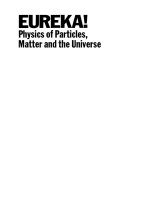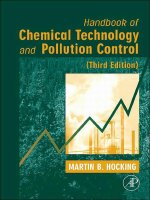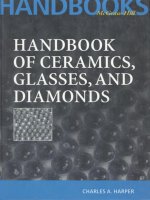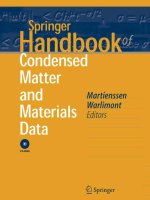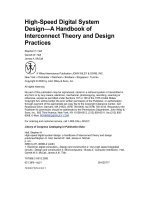handbook of condensed matter and materials data (springer, 2005)
Bạn đang xem bản rút gọn của tài liệu. Xem và tải ngay bản đầy đủ của tài liệu tại đây (21.01 MB, 1,143 trang )
Springer Handbook
of Condensed Matter and Materials Data
Springer Handbook provides
a concise compilation of approved
key information on methods of
research, general principles, and
functional relationships in physics
and engineering. The world’s lead-
ing experts in the fields of physics
and engineering will be assigned by
one or several renowned editors to
write the chapters comprising each
volume. The content is selected by
these experts from Springer sources
(books, journals, online content)
and other systematic and approved
recent publications of physical and
technical information.
The volumes will be designed to
be useful as readable desk reference
book to give a fast and comprehen-
sive overview and easy retrieval of
essential reliable key information,
including tables, graphs, and bibli-
ographies. References to extensive
sources are provided.
123
Handbook
Springer
of Condensed Matter and
Materials Data
W. Martienssen and H. Warlimont (Eds.)
With 1025 Figures and 914 Tables
Professor Werner Martienssen
Universität Frankfurt
Fachbereich 13, Physik
Robert-Mayer-Str. 2 – 4
60325 Frankfurt
Germany
Professor Hans Warlimont
IWF Dresden
Helmholzstr. 20
01069 Dresden
Germany
Library of Congress Control Number: 2004116537
ISBN 3-540-44376-2
Spinger Berlin Heidelberg New York
This work is subject to copyright. All rights reserved, whether the whole
or part of the material is concerned, specifically the rights of translation,
reprinting, reuse of illustrations, recitation, broadcasting, reproduction on
microfilm or in any other way, and storage in data banks. Duplication of this
publication or parts thereof is permitted only under the provisions of the
German Copyright Law of September, 9, 1965, in its current version, and
permission for use must always be obtained from Springer. Violations are
liable for prosecution under the German Copyright Law.
Springer is a part of Springer Science+Business Media
springeronline.com
c
Springer Berlin Heidelberg 2005
Printed in Germany
The use of designations, trademarks, etc. in this publication does not imply,
even in the absence of a specific statement, that such names are exempt from
the relevant protective laws and regulations and therefore free for general
use.
Product liability: The publisher cannot guarantee the accuracy of any
information about dosage and application contained in this book. In every
individual case the user must check such information by consulting the
relevant literature.
Production and typesetting: LE-TeX GbR, Leipzig
Handbook coordinator: Dr. W. Skolaut, Heidelberg
Typography, layout and illustrations: schreiberVIS, Seeheim
Cover design: eStudio Calamar Steinen, Barcelona
Cover production: design&production GmbH, Heidelberg
Printing and binding: Stürtz Würzburg
Printed on acid-free paper
SPIN 10678245 62/3141/ 5 4 3 2 1 0
GmbH,
V
Preface
The Springer Handbook of Condensed Matter and Ma-
terials Data is the realization of a new concept in
reference literature, which combines introductory and
explanatory texts with a compilation of selected data
and functional relationships from the fields of solid-
state physics and materials in a single volume. The data
have been extracted from various specialized and more
comprehensive data sources, in particular the Landolt–
Börnstein data collection, as well as more recent
publications. This Handbook is designed to be used as
a desktop reference book for fast and easy finding of es-
sential information and reliable key data. References to
more extensivedatasources are providedin each section.
The main users of this new Handbook are envisaged to
be students, scientists, engineers, and other knowledge-
seeking persons interested and engaged in the fields of
solid-state sciences and materials technologies.
The editors have striven to find authors for the
individual sections who were experienced in the full
breadth of their subject field and ready to provide suc-
cinct accounts in the form of both descriptive text and
representative data. It goes without saying that the sec-
tions represent the individual approaches of the authors
to their subject and their understanding of this task.
Accordingly, the sections vary somewhat in character.
While some editorial influence was exercised, the flexi-
bility that we have shown is deliberate. The editors are
grateful to all of the authors for their readiness to pro-
vide a contribution, and to cooperate in delivering their
manuscripts and by accepting essentially all alterations
which the editors requested to achieve a reasonably
coherent presentation.
An onerous task such as this could not have been
completed without encouragement and support from the
Prof. Werner Martienssen
Prof. Hans Warlimont
publisher. Springer has entrusted
us with this novel project, and
Dr. Hubertus von Riedesel has been
a persistent but patient reminder and
promoter of our work throughout.
Dr. Rainer Poerschke has accompa-
nied and helped the editors constantly
with his professional attitude and
very personable style during the
process of developing the concept,
soliciting authors, and dealing with
technical matters. In the later stages,
Dr. Werner Skolaut became a relent-
less and hard-working member of
our team with his painstaking con-
tribution to technically editing the
authors’ manuscripts and linking the
editors’ work with the copy editing
and production of the book.
We should also like to thank our families for having
graciously tolerated the many hours we have spent in
working on this publication.
We hope that the users of this Handbook, whose
needs we have tried to anticipate, will find it helpful and
informative. In view of the novelty of the approach and
any possible inadvertent deficiencies which this first edi-
tion may contain, we shall be grateful for any criticisms
and suggestions which could helptoimprovesubsequent
editions so that they will serve the expectations of the
users even better and more completely.
September 2004 Werner Martienssen,
Frankfurt am Main, Dresden Hans Warlimont
VI
This page intentionally left blank
VII
List of Authors
Wolf Assmus
Johann Wolfgang Goethe-University
Physics Department
Robert-Mayer-Str. 2 – 4
60054 Frankfurt am Main, Germany
e-mail:
Stefan Brühne
Johann Wolfgang Goethe-University
Physics Department
Robert-Mayer-Str. 2 – 4
60054 Frankfurt am Main, Germany
e-mail:
Fabrice Charra
Commissariat à l’Énergie Atomique, Saclay
Département de Recherche sur l’État Condensé,
les Atomes et les Molécules
DRECAM-SPCSI, Centre d’Études de Saclay
91191 Gif-sur-Yvette, France
e-mail:
Gianfranco Chiarotti
University of Rome “Tor Vergata“
Department of Physics
Via della Ricerca Scientifica 1
00133 Roma, Italy
e-mail:
Claus Fischer
Formerly Institute of Solid State and Materials
Research (IFW)
Georg-Schumann-Str. 20
01187 Dresden, Germany
e-mail:
Günter Fuchs
Leibniz Institute for Solid State and Materials
Research (IFW) Dresden
Magnetism and Superconductivity in the Institute
of Metallic Materials
Helmholtzstraße 20
01171 Dresden, Germany
e-mail:
Frank Goodwin
International Lead Zinc Research Organization, Inc.
PO BOX 12036
Research Triangle Parc, NC 27709, USA
e-mail:
Susana Gota-Goldmann
Commissariat à l’Energie Atomique (CEA)
Direction de la Recherche Technologique (DRT)
Centre de Fontenay aux Roses BP 6
92265 Fontenay aux Roses Cédex, France
e-mail:
Sivaraman Guruswamy
University of Utah
Metallurgical Engineering
135 South 1460 East RM 412
Salt Lake City, UT 84112-0114, USA
e-mail:
Gagik G. Gurzadyan
Technical University of Munich
Institute for Physical and Theoretical Chemistry
Lichtenbergstrasse 4
85748 Garching, Germany
e-mail:
Hideki Harada
High Tech Association Ltd.
3730-30 Higashikaya, Fukaya,Saitama, Japan
e-mail:
Bernhard Holzapfel
Leibniz Institute for Solid State and Materials
Research Dresden – Institute of Metallic Materials
Superconducting Materials
Helmholtzstr. 20
01069 Dresden, Germany
e-mail:
VIII List of Authors
Karl U. Kainer
GKSS Research Center Geesthacht
Institute for Materials Research
Max-Planck-Str. 1
21502 Geesthacht, Germany
e-mail:
Catrin Kammer
METALL – Intl. Journal for Metallurgy
Kielsche Straße 43B
38642 Goslar, Germany
e-mail:
Wolfram Knabl
Plansee AG
Technology Center
6600 Reutte, Austria
e-mail:
Alfred Koethe
Leibniz-Institut für Festkörper- und
Werkstoffforschung
Institut für Metallische Werkstoffe (retired)
Lessingstrasse 11
01099 Dresden, Germany
e-mail:
Dieter Krause
Schott AG
Research and Technology-Development
PO BOX 2480
55014 Mainz, Germany
e-mail:
Manfred D. Lechner
Universität Osnabrück
Institut für Chemie – Physikalische Chemie
Barbarastraße 7
46069 Osnabrück, Germany
e-mail:
Gerhard Leichtfried
Plansee AG
Technology Center
6600 Reutte, Austria
e-mail:
Werner Martienssen
Universität Frankfurt/Main
Physikalisches Institut
Robert-Mayer-Strasse 2 – 4
60054 Frankfurt/Main, Germany
e-mail:
Toshio Mitsui
Osaka University
Nakasuji-Yamate, 3-6-24
665-0875 Takarazuka, Japan
e-mail:
Manfred Müller
Dresden University of Technology
Institute of Materials Science
Leubnitzer Straße 26
01069 Dresden, Germany
e-mail:
Sergei Pestov
Moscow State Academy of Fine Chemical
Technology
Department of Inorganic Chemistry
Vernadsky pr., 86
119571 Moscow, Russia
e-mail:
Günther Schlamp
Metallgesellschaft Ffm and Degussa
Demetron (retired)
Stettinerstr. 25
61449 Steinbach/Ts, Germany
e-mail:
Barbara Schüpp-Niewa
Leibniz-Institute for Solid State and Materials
Research Dresden
Institute for Metallic Materials
Helmholtzstraße 20
01069 Dresden, Germany
e-mail:
Roland Stickler
University of Vienna
Department of Chemistry
Währingerstr. 42
1090 Vienna, Austria
e-mail:
List of Authors IX
Pancho Tzankov
Max Born Institute for Nonlinear Optics
and Short Pulse Spectroscopy
Max-Born-Str. 2A
12489 Berlin, Germany
e-mail:
Volkmar Vill
University of Hamburg
Department of Chemistry,
Institute of Organic Chemistry
Martin-Luther-King-Platz 6
20146 Hamburg, Germany
e-mail:
Hans Warlimont
DSL Dresden Material-Innovation GmbH
Helmholtzstrasse 20
01069 Dresden, Germany
e-mail:
X List of Authors
This page intentionally left blank
XI
Contents
List of Abbreviations XV
Part 1 General Tables
1 The Fundamental Constants
Werner Martienssen 3
1.1 What are the Fundamental Constants
and Who Takes Care of Them? 3
1.2 The CODATA Recommended Values of the Fundamental Constants 4
References 9
2
The International System of Units (SI), Physical Quantities,
and Their Dimensions
Werner Martienssen 11
2.1 The International System of Units (SI) 11
2.2 Physical Quantities 12
2.3 The SI Base Units 13
2.4 The SI Derived Units 16
2.5 Decimal Multiples and Submultiples of SI Units 19
2.6 Units Outside the SI 20
2.7 Some Energy Equivalents 24
References 25
3
Rudiments of Crystallography
Wolf Assmus, Stefan Brühne 27
3.1 Crystalline Materials 28
3.2 Disorder 38
3.3 Amorphous Materials 39
3.4 Methods for Investigating Crystallographic Structure 39
References 41
Part 2 The Elements
1 The Elements
Werner Martienssen 45
1.1 Introduction 45
1.2 Description of Properties Tabulated 46
1.3 Sources 49
1.4 Tables of the Elements in Different Orders 49
1.5 Data 54
References 158
XII Contents
Part 3 Classes of Materials
1 Metals
Frank Goodwin, Sivaraman Guruswamy, Karl U. Kainer, Catrin Kammer,
Wolfram Knabl, Alfred Koethe, Gerhard Leichtfried, Günther Schlamp,
Roland Stickler, Hans Warlimont
161
1.1 Magnesium and Magnesium Alloys 162
1.2 Aluminium and Aluminium Alloys 171
1.3 Titanium and Titanium Alloys 206
1.4 Zirconium and Zirconium Alloys 217
1.5 Iron and Steels 221
1.6 Cobalt and Cobalt Alloys 272
1.7 Nickel and Nickel Alloys 279
1.8 Copper and Copper Alloys 296
1.9 Refractory Metals and Alloys 303
1.10 Noble Metals and Noble Metal Alloys 329
1.11 Lead and Lead Alloys 407
References 422
2
Ceramics
Hans Warlimont 431
2.1 Traditional Ceramics and Cements 432
2.2 Silicate Ceramics 433
2.3 Refractory Ceramics 437
2.4 Oxide Ceramics 437
2.5 Non-Oxide Ceramics 451
References 476
3
Polymers
Manfred D. Lechner 477
3.1 Structural Units of Polymers 480
3.2 Abbreviations 482
3.3 Tables and Figures 483
References 522
4
Glasses
Dieter Krause 523
4.1 Properties of Glasses – General Comments 526
4.2 Composition and Properties of Glasses 527
4.3 Flat Glass and Hollowware 528
4.4 Technical Specialty Glasses 530
4.5 Optical Glasses 543
4.6 Vitreous Silica 556
4.7 Glass-Ceramics 558
4.8 Glasses for Miscellaneous Applications 559
References 572
Contents XIII
Part 4 Functional Materials
1 Semiconductors
Werner Martienssen 575
1.1 Group IV Semiconductors and IV–IV Compounds 578
1.2 III–V Compounds 604
1.3 II–VI Compounds 652
References 691
2
Superconductors
Claus Fischer, Günter Fuchs, Bernhard Holzapfel, Barbara Schüpp-Niewa,
Hans Warlimont
695
2.1 Metallic Superconductors 696
2.2 Non-Metallic Superconductors 711
References 749
3
Magnetic Materials
Hideki Harada, Manfred Müller, Hans Warlimont 755
3.1 Basic Magnetic Properties 755
3.2 Soft Magnetic Alloys 758
3.3 Hard Magnetic Alloys 794
3.4 Magnetic Oxides 811
References 814
4
Dielectrics and Electrooptics
Gagik G. Gurzadyan, Pancho Tzankov 817
4.1 Dielectric Materials: Low-Frequency Properties 822
4.2 Optical Materials: High-Frequency Properties 824
4.3 Guidelines for Use of Tables 826
4.4 Tables of Numerical Data for Dielectrics and Electrooptics 828
References 890
5
Ferroelectrics and Antiferroelectrics
Toshio Mitsui 903
5.1 Definition of Ferroelectrics and Antiferroelectrics 903
5.2 Survey of Research on Ferroelectrics 904
5.3 Classification of Ferroelectrics 906
5.4 Physical Properties of 43 Representative Ferroelectrics 912
References 936
Part 5 Special Structures
1 Liquid Crystals
Sergei Pestov, Volkmar Vill 941
1.1 Liquid Crystalline State 941
1.2 Physical Properties of the Most Common Liquid Crystalline Substances 946
XIV Contents
1.3 Physical Properties of Some Liquid Crystalline Mixtures 975
References 977
2
The Physics of Solid Surfaces
Gianfranco Chiarotti 979
2.1 The Structure of Ideal Surfaces 979
2.2 Surface Reconstruction and Relaxation 986
2.3 Electronic Structure of Surfaces 996
2.4 Surface Phonons 1012
2.5 The Space Charge Layer at the Surface of a Semiconductor 1020
2.6 Most Frequently Used Acronyms 1026
References 1029
3
Mesoscopic and Nanostructured Materials
Fabrice Charra, Susana Gota-Goldmann 1031
3.1 Introduction and Survey 1031
3.2 Electronic Structure and Spectroscopy 1035
3.3 Electromagnetic Confinement 1044
3.4 Magnetic Nanostructures 1048
3.5 Preparation Techniques 1063
References 1066
Acknowledgements 1073
About the Authors 1075
Detailed Contents 1081
Subject Index 1091
XV
List of Abbreviations
2D-BZ 2-dimensional Brillouin zone
2P-PES 2-photon photoemission spectroscopy
A
AES Auger electron spectroscopy
AFM atomic force microscope
AISI American Iron and Steel Institute
APS appearance potential spectroscopy
ARUPS angle-resolved ultraviolet photoemission
spectroscopy
ARXPS angle-resolved X-ray photoemission
spectroscopy
ASTM American Society for Testing
and Materials
ATR attenuated total reflection
B
BBZ bulk Brillouin zone
BIPM Bureau International des Poids et Mesures
BZ Brillouin zone
C
CB conduction band
CBM conduction band minimum
CISS collision ion scattering spectroscopy
CITS current imaging tunneling spectroscopy
CMOS complementary
metal–oxide–semiconductor
CODATA Committee on Data for Science and
Technology
CVD chemical vapour deposition
D
DFB distributed-feedback
DFG difference frequency generation
DOS density of states
DSC differential scanning calorimetry
DTA differential thermal analysis
E
EB electron-beam melting
ECS electron capture spectroscopy
EELS electron-energy loss spectroscopy
ELEED elastic low-energy electron diffraction
ESD electron-stimulated desorption
EXAFS extended X-ray absorption fine structure
F
FEM field emission microscope/microscopy
FIM field ion microscope/microscopy
G
GMR giant magnetoresistance
H
HAS helium atom scattering
HATOF helium atom time-of-flight spectroscopy
HB Brinell hardness number
HEED high-energy electron diffraction
HEIS high-energy ion scattering/high-energy ion
scattering spectroscopy
HK Knoop hardness
HOPG highly oriented pyrolytic graphite
HPDC high-pressure die casting
HR-EELS high-resolution electron energy loss
spectroscopy
HR-LEED high-resolution LEED
HR-RHEED high-resolution RHEED
HREELS high-resolution electron energy loss
spectroscopy
HRTEM high-resolution transition electron
microscopy
HT high temperature
HTSC high-temperature superconductor
HV Vicker’s Hardness
I
IACS International Annealed Copper Standard
IB ion bombardment
IBAD ion-beam-assisted deposition
ICISS impact ion scattering spectroscopy
ICSU International Council of the Scientific
Unions
IPE inverse photoemission
IPES inverse photoemission spectroscopy
ISO International Organization for
Standardization
ISS ion scattering spectroscopy
IUPAC International Union of Pure and Applied
Chemistry
J
JDOS joint density of states
XVI List of Abbreviations
K
KRIPES K-resolved inverse photoelectron
spectroscopy
L
LAPW linearized augmented-plane-wave
method
LB Langmuir–Blodgett
LCM liquid crystal material
LCP liquid crystal polymer
LCs liquid crystals
LDA local-density approximation
LDOS local density of states
LEED low-energy electron diffraction
LEIS low-energy ion scattering/low-energy ion
scattering spectroscopy
LPE liquid phase epitaxy
M
MBE molecular-beam epitaxy
MD molecular dynamics
MEED medium-energy electron diffraction
MEIS medium-energy ion
scattering/medium-energy ion scattering
spectroscopy
MFM magnetic force microscopy
ML monolayer
MOCVD metal-organic chemical vapor deposition
MOKE magneto-optical Kerr effect
MOSFET MOS field-effect transistor
MQW multiple quantum well
N
NICISS neutral impact collision ion scattering
spectroscopy
NIMs National Institutes for Metrology
O
OPO optical parametric oscillation
P
PDS photothermal displacement spectroscopy
PED photoelectron diffraction
PES photoemission spectroscopy
PLAP pulsed laser atom probe
PLD pulsed laser deposition
PSZ stabilized zirconia
PZT piezoelectric material
R
RAS reflectance anisotropy spectroscopy
RE rare earth
REM reflection electron microscope/
microscopy
RHEED reflection high-energy electron diffraction
RIE reactive ion etching
RPA random-phase approximation
RT room temperature
RTP room temperaure and standard pressure
S
SAM self-assembled monolayer
SAM scanning Auger microscope/microscopy
SARS scattering and recoiling ion
spectroscopy
SAW surface acoustic wave
SBZ surface Brillouin zone
SCLS surface core level shift
SDR surface differential reflectivity
SEM scanning electron microscope
SEXAFS surface-sensitive EXAFS
SFG sum frequency generation
SH second harmonic
SHG second-harmonic generation
SI Système International d’Unités
SIMS secondary-ion mass spectroscopy
SNR signal-to-noise ratio
SPARPES spin polarized angle-resolved
photoemission spectroscopy
SPIPES spin-polarized inverse photoemission
spectroscopy
SPLEED spin-polarized
SPV surface photovoltage spectroscopy
SQUIDS superconducting quantum interference
devices
SS surface state
STM scanning tunneling microscope/
microscopy
STS scanning tunneling spectroscopy
SXRD surface X-ray diffraction
T
TAFF thermally activated flux flow
TEM transmission electron
microscope/microscopy
TFT thin-film transistor
TMR tunnel magnetoresistance
TMT thermomechanical treatment
TOF time of flight
TOM torsion oscillation magnetometry
List of Abbreviations XVII
TRS truncation rod scattering
TTT time-temperature-transformation
U
UHV ultra-high vacuum
UPS ultraviolet photoemission spectroscopy
UV ultraviolet
V
VBM valence band maximum
VLEED very low-energy electron diffraction
X
XPS X-ray photoemission spectroscopy
XVIII
This page intentionally left blank
1
General Ta
Part 1
Part 1 General Tables
1 The Fundamental Constants
Werner Martienssen, Frankfurt/Main, Germany
2 The International System of Units (SI), Physical
Quantities, and Their Dimensions
Werner Martienssen, Frankfurt/Main, Germany
3 Rudiments of Crystallography
Wolf Assmus, Frankfurt am Main, Germany
Stefan Brühne, Frankfurt am Main, Germany
2
This page intentionally left blank
3
The Fundame
1.1. The Fundamental Constants
In the quantitative description of physical
phenomena and physical relationships, we
find constant parameters which appear to be
independent of the scale of the phenomena,
independent of the place where the phenomena
happen, and independent of the time when the
phenomena is observed. These parameters are
called fundamental constants. In Sect. 1.1.1, we give
a qualitative description of these basic parameters
and explain how “recommended values” for the
numerical values of the fundamental constants are
found. In Sect. 1.1.2, we present tables of the most
recently determined recommended numerical
values for a large number of those fundamental
constants which play a role in solid-state physics
and chemistry and in materials science.
1.1.1 What are the Fundamental Constants
and Who Takes Care of Them? 3
1.1.2 The CODATA Recommended Values
of the Fundamental Constants 4
1.1.2.1 The Most Frequently Used
Fundamental Constants 4
1.1.2.2 Detailed Lists
of the Fundamental Constants
in Different Fields of Application 5
1.1.2.3 Constants from Atomic Physics
and Particle Physics 7
References 9
1.1.1 What are the Fundamental Constants and Who Takes Care of Them?
The fundamental constants are constant parameters in
the laws of nature. They determine the size and strength
of the phenomena in the natural and technological
worlds. We conclude from observation that the numer-
ical values of the fundamental constants are independent
of space and time; at least, we can say that if there is any
dependence of the fundamental constants on space and
time, then this dependence must be an extremely weak
one. Also, we observe that the numerical values are in-
dependent of the scale of the phenomena observed; for
example, they seem to be the same in astrophysics and
in atomic physics. In addition, the numerical values are
quite independent of the environmental conditions. So
we have confidence in the idea that the numerical val-
ues of the fundamental constants form a set of numbers
which are the same everywhere in the world, and which
have been the same in the past and will be the same in the
future. Whereas the properties of all material objects in
nature are more or less subject to continuous change, the
fundamental constantsseem to represent a constituent of
the world which is absolutely permanent.
On thebasis of this expected invariance of the funda-
mental constants inspace and time, it appears reasonable
to relate the units of measurement for physical quanti-
ties to fundamental constants as far as possible. This
would guarantee that also the units of measurement
become independent of space and time and of envi-
ronmental conditions. Within the frame work of the
International System of Units (Système International
d’Unités, abbreviated to SI), the International Com-
mittee for Weights and Measures (Comité International
des Poids et Mesures, CIPM) has succeeded in relat-
ing a large number of units of measurement for physical
quantities to the numerical values of selected funda-
mental constants; however, several units for physical
quantities are still represented by prototypes. For ex-
ample, the unit of length 1 meter, is defined as the
distance light travels in vacuum during a fixed time; so
the unit of lengthis related to the fundamental constantc,
i. e. the speed of light, and the unit of time, 1second. The
unit of mass, 1 kilogram, however, is still represented
by a prototype, the mass of a metal cylinder made of
a platinum–iridium alloy, which is carefully stored at the
International Office for Weights and Measures (Bureau
International des Poids et Mesures, BIPM), at Sèvres
near Paris. In a few years, however, it might become
possible also to relate the unit of mass to one or more
fundamental constants.
Part 1 1
4 Part 1 General Tables
The fundamental constants play an important role in
basic physics as well as in applied physics and technol-
ogy; in fact, they have a key function in the development
of a system of reproducible and unchanging units for
physical quantities. Nevertheless, there is, at present, no
theory which would allow us to calculate the numerical
values of the fundamental constants. Therefore, national
institutes for metrology (NIMs), together with research
institutes and university laboratories, are making efforts
worldwide to determine the fundamental constants ex-
perimentally with the greatest possible accuracy and
reliability. This, of course, is a continuous process, with
hundreds of new publications every year.
The Committee on Data for Science and Technology
(CODATA), established in 1966 as an interdisciplinary,
international committee of the International Council of
the Scientific Unions (ICSU), has taken the responsi-
bility for improving the quality, reliability, processing,
management, and accessibility of data of importance to
science and technology. The CODATA task group on
fundamental constants, established in 1969, has taken
on the job of periodically providing the scientific and
technological community with a self-consistent set of
internationally recommended values of the fundamen-
tal constants based on all relevant data available at given
points in time.
What is the meaning of “recommended values” of
the fundamental constants?
Many fundamental constants are not independent of
one another; they are related to one another by equations
which allow one to calculate a numerical value for one
particular constant from the numerical values of other
constants. In consequence, the numerical value of a con-
stant can be determined either by measuring it directly or
by calculating it from the measured values of other con-
stants related to it. In addition, there are usually several
different experimental methods for measuring the value
of any particular fundamental constant. This allows one
to compute an adjustment on the basis of a least-squares
fit to the whole set of experimental data in order to deter-
mine a set of best-fitting fundamental constants from the
large set of all experimental data. Such an adjustment is
done today about every four years by the CODATA task
group mentioned above. The resulting set of best-fit val-
ues is then called the “CODATA recommended values
of the fundamental constants” based on the adjustment
of the appropriate year.
The tables in Sect. 1.1.2 show the CODATA recom-
mended values of the fundamental constants of science
and technology based on the 2002 adjustment. This ad-
justment takes into account all data that becameavailable
before 31 December 2002. A detailed description of
the adjustment has been published by Mohr and Taylor
of the National Institute of Standards and Technology,
Gaithersburg, in [1.1].
The editors of this Handbook, H. Warlimont and
W. Martienssen, would like to express their sincere
thanks to Mohr and Taylor forkindly putting their dataat
our disposal prior to publication in Reviews of Modern
Physics. These data first became available in December
2003 on the web site of the NIST fundamental constants
data center [1.2].
1.1.2 The CODATA Recommended Values of the Fundamental Constants
1.1.2.1 The Most Frequently Used Fundamental Constants
Tables 1.1-1 – 1.1-9 list the CODATA recommended values of the fundamental constants based on the 2002
adjustment.
Table 1.1-1 Brief list of the most frequently used fundamental constants
Quantity Symbol and relation Numerical value Units Relative standard
uncertainty
Speed of light in vacuum c 299 792 458 m/s Fixed by definition
Magnetic constant µ
0
= 4π ×10
−7
12.566370614 ×10
−7
N/A
2
Fixed by definition
Electric constant ε
0
= 1/(µ
0
c
2
) 8.854187817 ×10
−12
F/m Fixed by definition
Newtonian constant G 6.6742(10) ×10
−11
m
3
/(kg s
2
) 1.5×10
−4
of gravitation
Planck constant h 4.13566743(35) ×10
−15
eV s 8.5×10
−8
Reduced Planck constant =h/2π 6.58211915(56) ×10
−16
eV s 8.5×10
−8
Elementary charge e 1.60217653(14) ×10
−19
C 8.5×10
−8
Part 1 1.2
The Fundamental Constants 1.2 The CODATA Recommended Values of the Fundamental Constants 5
Table 1.1-1 Brief list of the most frequently used fundamental constants, cont.
Quantity Symbol and relation Numerical value Units Relative standard
uncertainty
Fine-structure constant α =(1/4πε
0
)(e
2
/ c) 7.297352568(24) ×10
−3
3.3×10
−9
Magnetic flux quantum Φ
0
= h/2e 2.06783372(18) ×10
−15
Wb 8.5×10
−8
Conductance quantum G
0
= 2e
2
/h 7.748091733(26) ×10
−5
S 3.3×10
−9
Rydberg constant R
∞
= α
2
m
e
c/2h 10973 731.568525(73) 1/m 6.6×10
−12
Electron mass m
e
9.1093826(16) ×10
−31
kg 1.7×10
−7
Proton mass m
p
1.67262171(29) ×10
−27
kg 1.7×10
−7
Proton–electron mass ratio m
p
/m
e
1836.15267261(85) 4.6×10
−10
Avogadro number N
A
, L 6.0221415(10) ×10
23
1.7×10
−7
Faraday constant F = N
A
e 96 485.3383(83) C 8.6×10
−8
Molar gas constant R 8.314472(15) J/K 1.7×10
−6
Boltzmann constant k = R/N
A
1.3806505(24) ×10
−23
J/K 1.8×10
−6
8.617343(15) ×10
−5
eV /K 1.8×10
−6
Stefan–Boltzmann constant σ =(π
2
/60)(k
4
/(
3
c
2
)) 5.670400(40) ×10
−8
W/(m
2
K
4
) 7.0×10
−6
1.1.2.2 Detailed Lists of the Fundamental Constants in Different Fields of Application
Table 1.1-2 Universal constants
Quantity Symbol and relation Numerical value Units Relative standard
uncertainty
Speed of light in vacuum c 299 792 458 m/s Fixed by definition
Magnetic constant µ
0
= 4π ×10
−7
12.566370614 ×10
−7
N/A
2
Fixed by definition
Electric constant ε
0
= 1/(µ
0
c
2
) 8.854187817 ×10
−12
F/m Fixed by definition
Characteristic impedance Z
0
= (µ
0
/ε
0
)
1/2
= µ
0
c 376.730313461 Ω Fixed by definition
of vacuum
Newtonian constant G 6.6742(10) ×10
−11
m
3
/(kg s
2
) 1.5×10
−4
of gravitation
Reduced Planck constant G/ c 6.7087(10) ×10
−39
(GeV/c
2
)
−2
1.5×10
−4
Planck constant h 6.6260693(11) ×10
−34
Js 1.7×10
−7
4.13566743(35) ×10
−15
eV s 8.5×10
−8
(Ratio) = h/2π 1.05457168(18) ×10
−34
Js 1.7×10
−7
6.58211915(56) ×10
−16
eV s 8.5×10
−8
(Product) c 197.326968(17) MeV fm 8.5×10
−8
(Product) c
1
= 2πhc
2
3.74177138(64) ×10
−16
Wm
2
1.7×10
−7
(Product) (1/π)c
1
= 2hc
2
1.19104282(20) ×10
−16
Wm
2
/sr 1.7×10
−7
(Product) c
2
= h(c/k) 1.4387752(25) ×10
−2
mK 1.7×10
−6
Stefan–Boltzmann constant σ = (π
2
/60)(k
4
/(
3
c
2
)) 5.670400(40) ×10
−8
W/(m
2
K
4
) 7.0×10
−6
Wien displacement law b =λ
max
T =c
2
/4.965114231 2.8977685(51) ×10
−3
mK 1.7×10
−6
constant
Planck mass m
P
= ( c/G)
1/2
2.17645(16) ×10
−8
kg 7.5×10
−5
Planck temperature T
P
= (1/k)( c
5
/G)
1/2
1.41679(11) ×10
32
K 7.5×10
−5
Planck length l
P
= /m
P
c 1.61624(12) ×10
−35
m 7.5×10
−5
= ( G/c
3
)
1/2
Planck time t
P
=l
P
/c =( G/c
5
)
1/2
5.39121(40) ×10
−44
s 7.5×10
−5
Part 1 1.2
6 Part 1 General Tables
Table 1.1-3 Electromagnetic constants
Quantity Symbol and relation Numerical value Units Relative standard
uncertainty
Elementary charge e 1.60217653(14)×10
−19
C 8.5×10
−8
(Ratio) e/h 2.41798940(21) ×10
14
A/J 8.5×10
−8
Fine-structure constant α =(1/4πε
0
)(e
2
/ c) 7.297352568(24) ×10
−3
3.3×10
−9
Inverse fine-structure constant 1/α 137.03599911(46) 3.3×10
−9
Magnetic flux quantum Φ
0
= h/2e 2.06783372(18) ×10
−15
Wb 8.5×10
−8
Conductance quantum G
0
= 2e
2
/h 7.748091733(26) ×10
−5
S 3.3×10
−9
Inverse 1/G
0
12 906.403725(43) Ω 3.3×10
−9
of conductance quantum
Josephson constant
a
K
J
= 2e/h 483 597.879(41)×10
9
Hz/V 8.5×10
−8
von Klitzing constant
b
R
K
= h/e
2
= µ
0
c/2α 25 812.807449(86) Ω 3.3×10
−9
Bohr magneton µ
B
= e /2m
e
927.400949(80) ×10
−26
J/T 8.6×10
−8
5.788381804(39) ×10
−5
eV /T 6.7×10
−9
(Ratio) µ
B
/h 13.9962458(12) ×10
9
Hz/T 8.6×10
−8
(Ratio) µ
B
/hc 46.6864507(40) 1/(mT) 8.6×10
−8
(Ratio) µ
B
/k 0.6717131(12) K/T 1.8×10
−6
Nuclear magneton µ
N
= e /2m
p
5.05078343(43) ×10
−27
J/T 8.6×10
−8
3.152451259(21) ×10
−8
eV /T 6.7×10
−9
(Ratio) µ
N
/h 7.62259371(65) MHz/T 8.6×10
−8
(Ratio) µ
N
/hc 2.54262358(22) ×10
−2
1/(mT) 8.6×10
−8
(Ratio) µ
N
/k 3.6582637(64) ×10
−4
K/T 1.8×10
−6
a
See Table 1.2-16 for the conventional value adopted internationally for realizing representations of the volt using the Josephson effect.
b
See Table 1.2-16 for the conventional value adopted internationally for realizing representations of the ohm using the quantum Hall effect.
Table 1.1-4 Thermodynamic constants
Quantity Symbol and relation Numerical value Units Relative standard
uncertainty
Avogadro number N
A
, L 6.0221415(10) ×10
23
1.7×10
−7
Atomic mass constant u = (1/12)m(
12
C) 1.66053886(28) ×10
−27
kg 1.7×10
−7
= (1/N
A
) ×10
−3
kg
Energy equivalent m
u
c
2
1.49241790(26) ×10
−10
J 1.7×10
−7
of atomic mass constant 931.494043(80) MeV 8.6×10
−8
Faraday constant F = N
A
e 96 485.3383(83) C 8.6×10
−8
Molar Planck constant N
A
h 3.990312716(27) ×10
−10
Js 6.7×10
−9
(Product) N
A
hc 0.11962656572(80) Jm 6.7×10
−9
Molar gas constant R 8.314472(15) J/K 1.7×10
−6
Boltzmann constant k = R/N
A
1.3806505(24) ×10
−23
J/K 1.8×10
−6
8.617343(15) ×10
−5
eV /K 1.8×10
−6
(Ratio) k/h 2.0836644(36) ×10
10
Hz/K 1.7×10
−6
(Ratio) k/hc 69.50356(12) 1/(mK) 1.7×10
−6
Molar volume of ideal gas V
m
= RT/p 22.413996(39) ×10
−3
m
3
1.7×10
−6
at STP at T = 273.15 K
and p =101.325 kPa
Loschmidt constant n
0
= N
A
/V
m
2.6867773(47) ×10
25
1/m
3
1.8×10
−6
Stefan–Boltzmann σ =(π
2
/60)(k
4
/(
3
c
2
)) 5.670400(40) ×10
−8
W/(m
2
K
4
) 7.0×10
−6
constant
Wien displacement law b = λ
max
T =c
2
/4.965114231 2.8977685(51) ×10
−3
mK 1.7×10
−6
constant
Part 1 1.2



